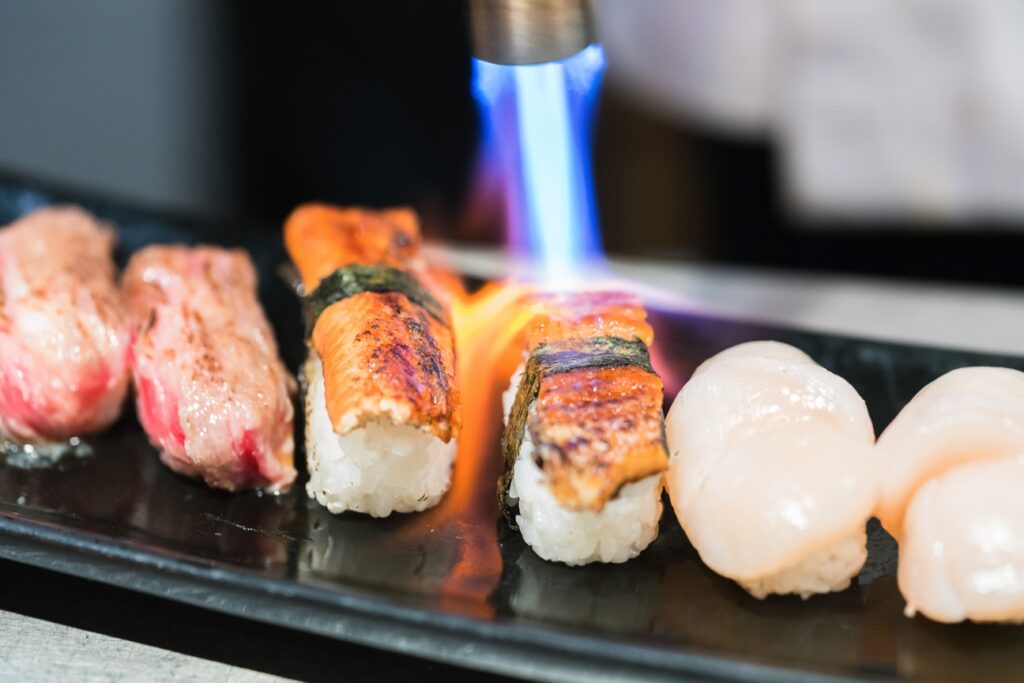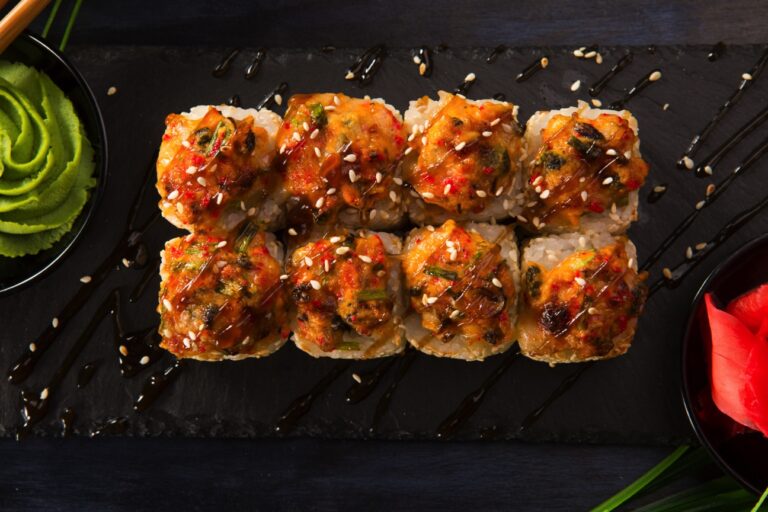
Aburi sushi is a type of nigiri (i.e. sushi that consists of a small ball of rice most commonly topped with a piece of raw fish) that has gently seared seafood or other toppings. This style of cooked sushi embodies the delicate balance between fire-kissed perfection and the purity of raw fish.
Origins and Evolution
The roots of aburi sushi can be traced back to Japan, a nation renowned for its culinary precision. The term “aburi” translates to “flame-seared” or “torched,” and can apply to any Japanese dish that can be seared. The technique involves using an open flame to sear the surface of the fish (or other ingredients), enhancing both texture and taste. This method was originally embraced as a side dish in upscale sushi establishments as a way to cater to the evolving preferences of patrons seeking new dimensions of flavor.
This torched style of sushi was introduced to North America, specifically Vancouver, in 2008 by Seigo Nakamura, the founder of Aburi Restaurants in Canada.
Technique: Mastering the Art
The art of aburi sushi hinges on the expertise of sushi chefs who have honed their skills through years of meticulous practice. To execute this technique, chefs carefully select cuts of premium fish, each boasting its distinct flavor profile. Whether it’s the rich marbling of fatty tuna or the delicate texture of salmon, the chosen fish is essential to the aburi experience.
Before the searing process begins, the chef brushes a thin layer of nikiri, a slightly sweet reduction crafted from shoyu (soy sauce), sake (rice wine), and mirin (sweet rice wine), onto the fish. This not only infuses the fish with a nuanced sweetness but also aids in the caramelization process during searing. The next step involves the precise application of an open flame, which lends a smoky char to the fish’s surface. This dance of fire is where culinary finesse truly shines, as the chef must balance the searing to achieve a harmonious contrast between the charred exterior and the raw interior.
Additionally, aburi sushi can be pressed into a rectangular shape to form oshizushi.
Flavors
The hallmark of aburi sushi is the combination of grilled and fresh flavors that dance across the taste buds. Like baked sushi, the searing process not only enhances the texture with a slight crispiness but also imparts a complexity that tantalizes the senses. The fusion of umami from the fish and the smokiness from the searing unite to deliver an experience that is both familiar and novel.
Moreover, aburi sushi showcases the chef’s mastery in orchestrating a variety of complementary components. From the choice of fish and nikiri sauce to the selection of toppings, each element plays a role in crafting a well-balanced bite. The toppings, often a medley of finely chopped herbs, tangy sauces, and zesty accents, contribute a burst of freshness that elevates the overall flavor profile.
Types of Aburi Sushi
Here are over a dozen different types of aburi sushi that have been served by various establishments (and might be available at your local sushi restaurant by special request).
- Aburi Nigiri: Various types of fish or seafood are lightly torched, creating a smoky and seared exterior while maintaining the delicate raw interior.
- Aburi Salmon Roll: A roll containing torched salmon, often accompanied by complementary ingredients.
- Aburi Scallop Nigiri: Torched scallops offer a unique texture and flavor profile.
- Aburi Yellowtail Nigiri: Yellowtail is carefully torched for a captivating taste experience.
- Aburi Salmon Belly Nigiri: The fatty belly of salmon is torched to create a melt-in-the-mouth delicacy.
- Aburi Eel Nigiri: Torched eel combines the smokiness of grilling with the indulgence of eel.
- Aburi Sushi Platter: A curated assortment of nigiri, each with torched elements, offering a range of flavors.
- Aburi Tuna Nigiri: Tuna, often toro (fatty tuna), is seared for a distinctive twist on traditional tuna nigiri.
- Aburi Hokkigai Nigiri: Surf clam is torched to enhance its sweetness and texture.
- Aburi Hamachi Nigiri: Yellowtail is carefully torched to bring out its natural flavors.
- Aburi Hotategai Nigiri: Scallops are lightly torched for a rich and delectable bite.
- Aburi Uni Nigiri: Sea urchin is torched to accentuate its creamy texture and umami notes.
- Aburi Wagyu Nigiri: A luxurious option where torched Wagyu beef adds depth to the sushi experience.
- Aburi King Crab Nigiri: Torching king crab adds a smoky dimension to its sweet and succulent taste.
- Aburi Lobster Nigiri: Torched lobster brings out its delicate flavors and introduces a caramelized touch.
Where to find aburi sushi
Although aburi sushi is not commonly seen on sushi menus, there are select Japanese restaurants that serve this style of sushi. While a bulk of aburi sushi restaurants are located in Southern California (e.g. Buena Park, Pasadena, Anaheim, etc.) you can find this style of sushi across the country. Take a look at this interactive map to find a location near you.
How to make it
If you don’t live near any areas that serve aburi sushi, you can make your own at home. Simply follow this recipe, or take the super quick shortcut as seen in the notes below. Enjoy!

aburi sushi
flame-seared sushi
Ingredients
sushi rice
- 2 cups sushi rice
- 2 1/2 cups water
- 1/3 cup rice vinegar
- 2 tablespoons sugar
- 1 teaspoon salt
nikiri sauce
- 1/4 cup soy sauce
- 2 tablespoons mirin (sweet rice wine)
- 1 tablespoon sake
- 1 teaspoon sugar
aburi sushi
- Assorted fresh fish slices (such as salmon, tuna, yellowtail, or white fish)
- Nori (seaweed) sheets, cut into strips
- Soy sauce, for dipping
- Wasabi and pickled ginger, for serving
- Optional toppings: thinly sliced green onions, sesame seeds, tobiko (fish roe), or microgreens
Instructions
Prepare the Sushi Rice:
- Rinse sushi rice until water runs clear.
- Cook rice according to package instructions.
- Mix rice vinegar, sugar, and salt in a bowl. Microwave briefly to dissolve sugar.
- Gently fold vinegar mixture into cooked rice. Let it cool at room temperature while fanning.
Prepare the Nikiri Sauce:
- Combine soy sauce, mirin, sake, and sugar in a small saucepan.
- Heat over medium-low heat until sugar dissolves. Allow sauce to cool.
Prepare the Fish:
- Slice fish into thin pieces that fit on rice.
Assemble the Aburi Sushi:
- Shape a small amount of sushi rice into bite-sized pieces with damp hands.
- Place a strip of nori on rice and add a slice of fish.
Searing the Fish:
- Use a kitchen torch to quickly and carefully torch the top of the fish until lightly seared and edges are charred.
Final Touches:
- Drizzle a bit of Nikiri sauce over seared fish.
- Add optional toppings like green onions, sesame seeds, tobiko.
Serve:
- Arrange Aburi Sushi on a platter.
- Serve with soy sauce, wasabi, and pickled ginger on the side.
Notes
If you want to take the very easy route, pick up some nigiri at your local Japanese restaurant and simply sear the fish and add a bit of nikiri sauce. 🙂
Recommended Products
Glutto earns a tiny commission from qualifying Amazon purchases.
Did you make this recipe?
Please leave a comment on the blog or share a photo on Instagram
In the realm of gastronomy, where tradition meets innovation, aburi sushi stands as a testament to the culinary journey. Through the art of flame-kissed precision, this technique bridges the gap between the raw and the cooked, offering a balance of flavors that captivates the senses.












